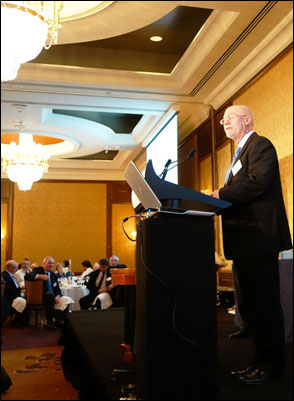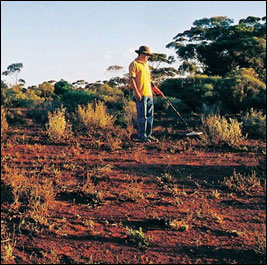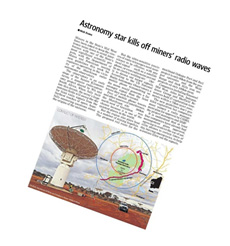Mineral Titles e-Newsletter - Department of Mines and Petroleum
Edition 3 - July 2014
Edition 3 - July 2014

DMP Executive Director of Mineral Titles Ivor Roberts at the AusIMM Awards Night in Melbourne 31 May 2014.
Welcome to the July 2014 eNewsletter for the Department of Mines and Petroleum's (DMP) Mineral Titles Division.
Early in May, Kevin Fuller, a very long term officer of my Division passed away after a short period of illness. Kevin was an extremely valuable member of the Mineral Titles team having worked his entire career for the Western Australian Mines Department. I would like to express my condolences to his family and all of his friends and colleagues.
The Mineral Titles Division is committed to improving the approval and compliance processes, and in reducing the backlog of pending tenement applications.
Mineral Titles Division continues to introduce improvements in the processes involved in the determination of tenement applications and is currently working closely with the Environment Division to ensure the smooth introduction of the Mine Rehabilitation Fund.
Western Australia competes globally for resource investment funds. It is thus pleasing that the Western Australian mining jurisdiction has improved in its international ranking as measured by the respected Fraser Institute Survey of Mining Companies. For the 2013 Fraser Institute’s survey, which was released in April 2014, Western Australia was ranked 6th out of 112 jurisdictions world-wide for the Policy Perception Index. This index is the most definitive and comprehensive of the Fraser Institutes Indices and provides what the Institute calls “a report card to governments on the attractiveness of their mining policies”. Western Australia was the only Australian State in the Survey’s top ten. Western Australia was also ranked the number one global mining jurisdiction for the Survey’s Investment Attractiveness Index, number two in the Best Practices Mineral Potential Index and ranked best in the world in terms of least uncertainty concerning existing regulations (Regulation Certainty Index).
I hope you enjoy this edition of the newsletter, and as always, I welcome any feedback.
Dr Ivor Roberts

The Mineral Titles Division commissioned Research Solutions to conduct a customer survey as a follow up to the 2010 customer survey. The main purpose of this survey was to ascertain satisfaction levels for a number of new initiatives that have come to fruition in the past three years.
The survey results indicated that Mineral Titles had progressed a long way since the 2010 survey, showing significant improvements in interactions with customers and launching a range of online systems to streamline customer contact with the Division.
Recommendations from the survey encourage Mineral Titles to:

It is with great sadness that we report the passing away of Kevin Fuller on Monday 5th May 2014.
Mineral Titles Executive Director Ivor Roberts expressed condolences to Kevin’s family and his many friends within the department and industry.
“Kevin will be sadly missed. As a very long serving officer of Mineral Titles, with over 43 years of service, he was well respected and liked throughout the department and industry,” Ivor said.
Kevin commenced with the Department of Mines on 11 February 1971 as a cadet draftsman, and worked his entire working career with the Department of Mines and Petroleum.
With a cadetship awarded by the Public Service Commission, Kevin obtained a Diploma of Cartography from the Wembley Campus of Technical and Further Education in 1975. Kevin worked as a Cartographic Draftsman until 1996 when the Surveys and Mapping Division was amalgamated with the Mineral Titles Division. He then worked as a tenure officer, covering all areas of exploration and mining tenure but specialising in compliance.
Kevin will be sadly missed.

Following the December 2013 inquest into the death of a prospector near Menzies earlier that year, the Department of Mines and Petroleum has sought to educate prospectors about the importance of being prepared before they go into the field. In particular, prospectors are urged to carry personal locator beacons (PLBs) when exploring in remote areas. Following two recent police searches for missing prospectors, the department is once again highlighting this message.
Eighty year-old prospector Ralph Craig sparked a search in late May when he failed to return to Coolgardie while exploring with a friend. Just last month Peter O'Shaughnessy, 76, also went missing in the goldfields. Both were found the following day in good health.
The department is urging both experienced and amateur prospectors to take responsibly for their own safety by carrying a personal locator beacon. The personal locator beacon is a small device that, when activated, transmits a message via satellite to emergency services. The device, which can be purchased from most outdoor stores, is ideal for use in remote areas as it does not rely on telecommunication networks to send a signal.
While the two recent incidents of missing prospectors ended happily, that was not the case for Michael Graham, who went missing and perished near Menzies last year. The month-long search for Mr Graham was the largest ever undertaken in Western Australia and covered more than 1,500 square kilometres.
During testimony given at the inquest into Mr Graham's death in January 2013, a WA Police representative said that carrying a PLB would help guarantee a persons' survival, as well as reduce the resources required for such searches. A GPS, which is carried by many prospectors, allows the carrier to locate themselves but does not assist any would-be rescuers. It is the PLB that provides information via satellite to searchers, and often initiates the search itself upon activation.
In 2013, nine prospectors were reported missing to the WA Police. Only one was carrying a PLB — and that person was found within four hours. Although the department cannot compel prospectors to carry a PLB, carrying one could help avoid future tragedies.
A new radio-astronomy observatory in the Murchison region of Western Australia is generating some restrictions on explorers and miners in the area.
The website relating to the Murchison Radio-astronomy Observatory in the Murchison region has been revised, providing the mineral resource industry with improved guidance for those companies working or considering working within the region.
Since the late 1990s there has been ongoing research and planning for the next generation radio-telescope. Australia’s CSIRO approached the Geological Survey about 17 years ago seeking to locate a suitable area for the operation of a “Square Kilometre Array” radio telescope, that the CSIRO intended bidding for to be built in Australia.

The CSIRO recognised the importance of locating the future observatory in isolated parts of Western Australia that did not have mines or a high potential for locating future mines. The two organisations worked closely over about three years prioritised a number of sites, undertook more detailed evaluations and eventually located an area centred roughly in the middle between Carnarvon, Meekatharra, Mount Magnet and Geraldton, mainly over Yilgarn Craton granites and granitic gneiss.
To preserve the radio-quiet integrity of the selected area from radio emissions, and particularly those coming from mineral exploration or mining activities, in 2001 the then Minister for Mines created two Mining Act Section 19 Exemption Areas (S19/157 and S19/158 total area of 17 000 square kilometres) over and around the selected area to prohibit the grant of tenements. These ensure there is total protection of the radio telescopes from radio interference close to the receivers that could be produced by mineral resource activities.
Subsequently, to ensure that activities from a broader area outside of the S19s did not create radio-frequency interference, a requirement was placed on tenements to manage the use of electrical and electronic equipment to ensure that any interference from such equipment will be kept to levels that are acceptably low. This area, formally referred to as the Radio Telescope Mineral Resource Management Area or RTMRMA, requires tenements to be granted with conditions requiring explorers and miners to work with electronic engineers with specialisation in radio-interference to produce a radio emissions management plan (REMP). Operations are then required to be conducted in compliance with the REMP.
Guidelines have been included in the Mineral Titles section of the DMP website explaining why and how the REMP is to be produced, what equipment it has to cover and some of the implications of the REMP. To help in compiling the REMP a stylised example is also available. Companies working in or considering working in the area are encouraged to refer to the website < http://www.dmp.wa.gov.au/5874.aspx > for more information.
While the website information is directed at exploration activities, similar requirements will apply to any consideration of a mining project in the region.
The Commonwealth, through the Australian Communications and Media Authority (ACMA), has also introduced restrictions on the use of licenced electronic equipment. These restrictions apply to various distances from the centre of the observatory depending on the frequency of operations. Links to these requirements can also be found on DMP’s website.
Under the guidance of the Executive Director, young employees of the Mineral Titles Division have produced a booklet giving an insight into the operation of the division. The publication is available at the Perth information counter as well as regional offices and is a good read for those seeking a different perspective of the division.
It is the responsibility of all tenement holders to be aware of impending expiry of tenements. The Mineral Titles Division does not advise holders when to apply for extension or renewal. However, the department does include the expiry date on annual rent reminder letters which are sent to holders.
In January this year, Bob Mulligan was appointed as the Mining Registrar for Marble Bar. Bob is responsible for the administration of the Marble Bar and Nullagine districts of the Pilbara mineral field.
Bob has an extensive back ground in the administration of occupational health and safety in the resources sector having previously worked as a Mines Safety inspector in Tasmania and more recently the principal consultant in his workplace safety consultancy and training services. Bob's extensive knowledge and practical application of legislative requirements stands him in good stead in performing the duties of the Mining Registrar.
Bob is no stranger to living in remote parts of Western Australia, having spent part of his childhood in Meekatharra where his father was posted as the resident Magistrate. Coincidently, Bob's father also worked for the Mines Department. In 1941 Bob's father started work as a messenger boy in Wiluna and, in 1952, was appointed as the Mining Registrar at Marble Bar. He worked there for the next eight years before being appointed as the Clerk of Courts at Broome, going on to be qualified as a Magistrate.
Bob and his wife and two young children are keen to be involved in the community and Bob has recently joined the volunteer Emergency Services in town.
Bob is not only responsible for the maintenance of the title registration functions of the Marble Bar and Nullagine districts of the Pilbara mineral field in the capacity of the Mining Registrar, but also carries on the functions of the Registrar of Courts under the Magistrates Courts Act and provides vehicle licensing services on behalf of the Department of Transport. Marble Bar is one of nine regional offices maintained by the Mineral Titles Division and one of several that provide multi agency services to the local community.
The Mineral Titles Division continues to make significant inroads into the number of outstanding applications for mining tenements that peaked in February 2007 at 18,745 outstanding applications. Through a series of measures including statutory reforms, the application of the State Government's native title future act policy, additional resources provided to the administration of warden's proceedings and enhancements to business systems, the number of outstanding mining tenement applications has been reduced to 4212 today, down from the 5436 applications that were outstanding this time last year.
Reducing the number of outstanding applications for mining tenements and the time taken to process these applications is imperative to attracting exploration for, and development of, the State's mineral resources. Outstanding applications for mining tenements cannot be accessed for mineral exploration purposes; it is the valid grant of mining tenements that provides the security to carry on exploration and the consequent development of the State's mineral resources.
Efficiencies in tracking outstanding mining tenement applications have been realised through business systems enhancements, particularly in the native title future act procedures, enabling the Tenure and Native Title Branch project officers to take a proactive role to ensure applications do not stall through that process.
The Mineral Title Division currently maintains the administration of over 22,000 mineral titles covering just over 531,000 square kilometres, or 21 per cent of the total 2.5 million square kilometres of the State. The majority of this area (472,000 square kilometres) is covered by exploration or prospecting licences, underpinning mineral exploration expenditure in Western Australia whch totalled $1.8 billion in 2012-13.
Clients should note that, in line with annual State Government fee increases, mining tenement rents and fees under the Mining Act 1978 will be increased from 1 July 2014 by 2.6 per cent.